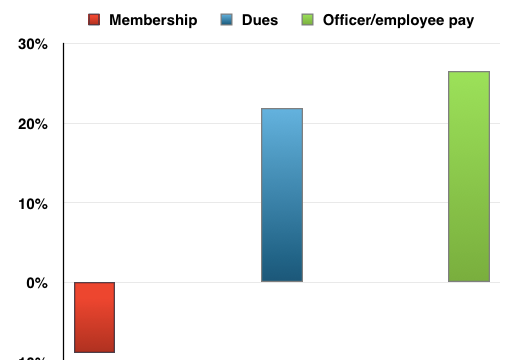Ohio teachers union loses members, hikes dues

By Jason Hart | Ohio Watchdog
The Ohio Education Association lost members and hiked dues this year, taking more money from fewer teachers and paying union president Becky Higgins $214,538.
According to OEA’s annual report to the U.S. Department of Labor for the fiscal year ending Aug. 31, membership dropped to 119,770 from 119,818 a year earlier. Regular member dues increased from $501 to $508.
Changes in OEA membership and dues this year were slight, but OEA has been losing members and increasing dues rates for over a decade. While membership has dropped, hiking dues has allowed OEA to dramatically increase the average pay of union officers and employees.
Average pay for OEA staff and officers increased from $100,435 in 2013 to $103,421 this year. Excluding board of directors members, OEA paid 213 officers and employees a total of $22 million this year.
In 2004, when the union had 131,000 members, OEA spent $18.3 million on officer and employee pay, an average of $79,750 per payee. How could OEA afford to pay $23,671 more, on average, in 2014?
OEA regular dues were $98 higher in 2014 than in 2004, an increase of 22 percent, while the union lost 9 percent of its members.
Higgins, in her first year as OEA president, was paid $4,213 less in 2014 than former president Patricia Frost-Brooks received in 2013. Vice president Scott DiMauro and secretary-treasurer Tim Myers were each paid more than $190,000 this year.
OEA has lost 11,230 members since 2004. With the exception of 2009 — when federal cash from President Obama’s “stimulus” bill began pouring into Ohio’s public schools — OEA membership has declined every year since 2003.
Combined with teacher compensation and layoff provisions locked into union contracts, shrinking property tax revenues after the 2007 housing market crash have cost thousands of Ohio teachers their jobs. OEA lost 1,862 members in 2011, 4,849 members in 2012 and 2,286 members in 2013.
This year OEA also reported an estimated $92,000 liability resulting from a class-action settlement with teachers who accused OEA of charging illegally excessive “fair share” fees. Because Ohio is not a right-to-work state, teachers can be forced to pay OEA fees as a condition of employment.
A total of 1,457 Ohioans were forced to pay fair share fees to OEA this year, down from 1,550 in 2013.
Of $52,467,875 in dues and fees received during the latest fiscal year, OEA spent $13,627,219 on representational activities, $12,204,273 on general overhead, $5,228,802 on “union administration” and $3,474,329 on political activities and lobbying.
OEA did not respond to a request for comment on the officer pay and membership figures reported in its 2014 Department of Labor filing.







